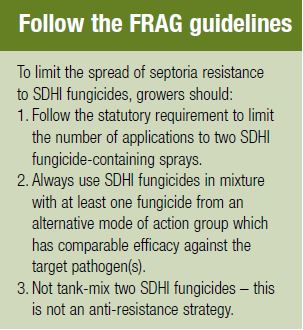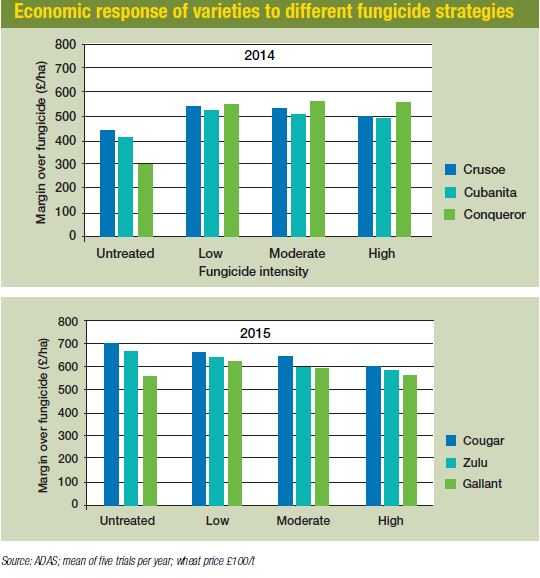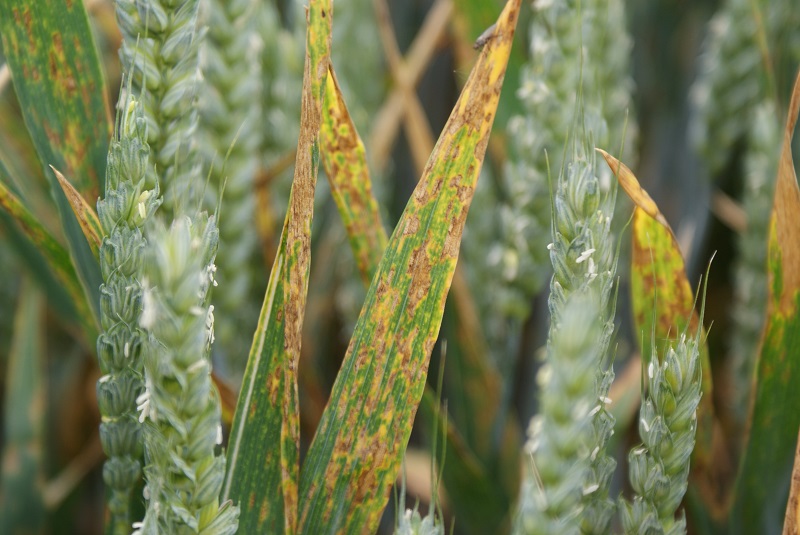
Guidance on how to use SDHI fungicides may be clear, but what will be the relative impact of resistance management strategies and how will septoria populations evolve? CPM asks key scientists for an update.
By Tom Allen-Stevens
The Pesticide Usage Survey for 2015 suggests the highest ever number of fungicide treatments were applied to wheat crops last year. Nearly all of them received four applications, with the biggest rise being seen in the number of sprays applied at the T0 timing.
And yet it was the year that saw the lowest levels in recent times of septoria.

Paul Gosling says an extra £30,000 of AHDB funding will go towards research specifically to monitor the new sdh mutation.
This has served to increase concern that fungicide applications are not matched to the in-season risk faced by
wheat crops, notes Dr Paul Gosling of AHDB Cereals and Oilseeds. “Growers are spending money they don’t need to spend and driving resistance at the same time. So this a double whammy that threatens the profitability of growing wheat in both the short and medium term.”
What cements the worry is the finding, announced in Feb, of a key mutation with the potential to confer high levels of SDHI resistance in UK septoria populations, detected at a field site in southern England and discovered as part of an AHDB monitoring project, led by Rothamsted Research.
This could have implications for SDHI fungicide efficacy, he points out. “It’s difficult to say at the moment just how significant this finding is. We don’t think the effect will be as dramatic as the spread of septoria resistance to strobilurin fungicides, and believe the mutation may carry a fitness cost that will limit how fast the isolates develop in the population.”
AHDB has now approved an extra £30,000 of research specifically to monitor this new mutation. “This will allow 48 sites to be sampled over the season and will build up a good picture of how this isolate has spread, and the speed with which it is developing,” he reports.
“But this is quite specific and will be carried out alongside ongoing research into azole sensitivity.”
Meanwhile, a significant industry-funded project looking at the consequences of intensive fungicide use is now drawing to a conclusion (see panel on page xx). “It’s clear that resistance must be taken seriously – azole sensitivity is going in only one direction, and it’s the intensity of azole use that’s driving it,” stresses Paul Gosling.
A new project, part funded by BASF, is now underway that aims to quantify how cultural control techniques, such as choice of variety, can contribute to overall disease management. “The previous project has shown they make a difference, although it’s still relatively small – there’s not much scope in the resistance of current varieties.
“Two new wheats on the AHDB Cereals and Oilseeds Recommended List with a rating of 7 for septoria is a step in the right direction, however. If the SDH mutation does turn out to be significant, as with herbicide resistance, cultural control will play more of a role and growers will need reliable information so they can plan how to use varietal resistance to best effect.”
The use of multi-site fungicides should also remain the backbone of disease control programmes, he adds. “They are powerful resistant-management tools. It’s clear growers are shifting the start of fungicide programmes to earlier in the season, which is where multi-sites fit in well. But a straight azole at T0 and T3 is a very unwise choice.”
Last year, around 1200 septoria isolates from wheat leaf samples taken at 16 sites across the UK were analysed by researchers at Rothamsted. The main purpose was to monitor changes in the CYP51 protein that bring reduced sensitivity to azole fungicides, explains lead researcher Dr Bart Fraaije.
“We’ve stepped up the monitoring and included four samples from France and two from Germany to improve our understanding of new azole-resistance mechanisms and CYP51 mutations that resistant isolates may have developed.”
Efflux pump
Among these is increased efflux pump activity, often due to overexpressing of the transporter MgMFS1, whereby the pathogen cells develop the ability to expel chemicals. Whether that’s an azole, QoI (strobilurin) or SDHI, the fungicide is pumped out before it has the chance to reach the target. This could increase resistance by up to ten times, depending on the fungicide. Another worrying development is the identification of strains combining all three resistance mechanisms: CYP51 mutations, CYP51 overexpression and increased efflux pump activity.
“The incidence of increased efflux pump activity is still low in septoria populations – currently at 0-6% across most UK and French locations sampled last season – although in a sample from Scotland and one site in N Germany, 20-33% of isolates displayed this property at the start of the season,” reports Bart Fraaije.
“Increased efflux pump activity is found in different CYP51 variants and the impact on fitness needs further investigation. With regard to CYP51 mutations, no new CYP51 variants were found in 2015.”
What researchers did find, however, could be far more sinister as far as SDHI sensitivity is concerned. “Three of the 195 late season isolates tested from one site in southern England showed medium to high resistance to SDHI fungicides.”
They’ve been on the look-out for the tell-tale mutations and have identified a range of different mutations in lab experiments that can confer resistance, he explains. “SDHIs work on three different sub units of the succinate dehydrogenase protein (SdhA, B and C), and you have to sequence all three genes to establish if target site changes confer resistance. One of the mutations we’re particularly interested in is the one causing C-H152R (amino acid histidine replaced by arginine at position 152 of the SdhC protein).
“The alarming thing about this target site change is that it gives the pathogen a much higher resistance capability. That’s the key mutation we’ve now identified from the field sample and was also reported in Ireland. In addition to C-H152R, seven other Sdh mutations conferring lower levels of resistance were also found for the first time in the UK in 2015.”
What they don’t yet know is whether the mutations carry a fitness cost. “The reason QoI resistance was so dramatic was that the mutation that conferred it (cytochrome b G143A) was associated with very high levels of resistance and didn’t affect the pathogen’s ability to survive and reproduce in any way. Whether the C-H152R mutation affects SDHI performance and carries a fitness penalty is exactly what we hope to find out through the extra monitoring and testing this year,” he notes.
Sampling at both the start and end of the season at 48 locations, mostly carried out by NIAB TAG, SRUC, ADAS and Teagasc in Ireland, will build up a picture of how this new threat is evolving. “We’ve also developed in-field diagnostic tests for CYP51 and MgMFS1 over-expressing strains, and hope to be able to demonstrate them at a future Cereals event.”
But the point about finding resistance is that it shouldn’t, in itself, change your approach in the field, according to Dr Neil Paveley of ADAS. “The strategies that are most effective at slowing resistance before you find it are also the most effective at keeping its spread minimised. So the key objective is to find out what these strategies are.”
That’s been the aim of a four-year project led by ADAS that draws to a conclusion this year. Four different fungicide treatment regimes have been applied to three wheat varieties, with a low, moderate and high septoria-resistance rating. Selection for azole-insensitive and efflux strains of septoria has been tracked and the economic response of the varieties to the fungicide regimes compared.
 The surprise finding of the trials is just how well a low-intensity fungicide programme has performed financially, even in a high disease year such as 2014, notes Neil Paveley. “The startling result from the 2015 season was the strong performance of the untreated plots, albeit on varieties where yellow rust was not much of an issue (see chart on below).
The surprise finding of the trials is just how well a low-intensity fungicide programme has performed financially, even in a high disease year such as 2014, notes Neil Paveley. “The startling result from the 2015 season was the strong performance of the untreated plots, albeit on varieties where yellow rust was not much of an issue (see chart on below).
“But that’s all with the benefit of hindsight. Growers started their 2015 fungicide programmes with the high disease pressure of the previous year in mind. Although the severity of septoria does not relate to the severity in the previous season, few would have risked a low-intensity programme.”
High gross margins
But more disease resistant varieties produce high gross margins and reduce the risk associated with lower intensity fungicide programmes, points out Neil Paveley. “Because disease epidemics grow more slowly on less susceptible varieties, disease forecasting works better, to match inputs to the season. The project has shown that the combination of resistant varieties and appropriate fungicide inputs does slow down fungicide insensitivity.”
Most growers would want some reliable facts and figures on which to base any change in strategy, however, argues Catriona Walker of ADAS. That’s the aim of a new set of trials that’ll run over the next three years on four sites across the UK plus one in Ireland.
“The aim is to deliver direct information on how cultural control techniques interact with different fungicide programmes – it’s a very farmer-focused project that will give growers a very clear picture on how to adapt strategies. In the event septoria develops significant resistance to SDHIs, we hope we can help growers adopt financially proportionate fungicide programmes,” she says.
Three varieties – KWS Santiago, JB Diego and Revelation – have been planted at mid-to-late Sept and mid-to-late Oct drilling dates at high and low seed rates. Four fungicide treatments, from untreated to high intensity, will be applied. “It will build into a regional picture on best economic return for fungicide use. But importantly it should equip growers with information how to optimise control, however septoria populations develop.”
Smarter approach needed as resistance evolves
Velcourt technical director Keith Norman reckons it was only a matter of time before septoria isolates with resistance to SDHI were detected in the UK. “We’ve been doing our own sampling work across our trials sites and have picked up another isolate this time in Suffolk with a different mutation to the one found in southern England earlier this year,” he reports.
“SDHIs have a similar mechanism to strobilurins, so this development was inevitable. However, the newer chemistry works on three sub units within the pathogen, rather than just the one site targeted by strobs, so resistance is not black-and-white, and I think we’ll see a slower degradation.”
It will be crucial for growers and agronomists to be kept informed of how the resistance picture evolves, however. “The AHDB-funded work in this area is vital, and it’s good news that extra resources have been allocated to monitor this new development – we need a truly independent system. But I’d like to see more monitoring and wider sampling on a national basis, and feel government funds should be used for such an approach,” maintains Keith Norman.
“We need the extra strength of SDHIs – there’s no doubt about it, as when the chips are down as they were in 2012 and 2014, it was clear that the azoles just don’t have the edge you could once rely on. But we should be wary of overuse – if your crop is clean at T1, why not save the Rolls Royce chemistry for just one application at the T2 timing, for example?”
Overuse of azoles will also drive resistance, he points out, although use must be appropriate to the individual situation. “This puts the emphasis on better monitoring – a pragmatic approach, where you regularly check on disease levels will help tailor a programme and identify where, for example, just chlorothalonil at T0 would suffice.”
Current AHDB-funded research will help growers and agronomists choose the right prescription of inputs for a given set of circumstances, he believes. “But what’s still lacking is a smarter approach to forecasting. There are technologies such as in-field tests and drone-mounted spectral photography that hold some promise in how they can help here, which may ensure the chemistry is better used to best effect in future.”
Research round-up
AHDB project 2012-3800, Consequences of intensive fungicide use or integrated disease management for fungicide resistance and sustainable control, runs from Jan 2013 to Sept 2016. Its aim is to quantify the effect of integrated disease management on selection of fungicide-resistant pathogen strains, translate this into implications for the effective life of fungicides, and interpret the implications. Its total cost is £691,546, and the project has industry partners Adama, BASF, Bayer CropScience, CRD, Defra, DuPont, Limagrain and Syngenta. AHDB funding amounts to £40,000, with the research carried out by ADAS and Rothamsted Research.
AHDB project 2140003105, Combining agronomy, variety and chemistry to maintain control of Septoria tritici in wheat, runs from Aug 2015 to March 2019. Its aim is to compare the value of cultural control measures as part of a disease management programme, specifically sowing date and disease-resistant varieties and to quantify this in terms of yield, disease control and margin over fungicide cost. Led by ADAS, its total cost is £359,163, funded by AHDB Cereals and Oilseeds, BASF and Teagasc.
AHDB project 2009-3713, Identification and characterisation of azole sensitivity shifts in Irish and UK populations of Mycosphaerella graminicola (Zymoseptoria tritici) sampled from AHDB fungicide performance winter wheat trials, runs from April 2011 to March 2019. Its aim is to identify changes to the CYP51 gene targeted by azoles in field populations of septoria leaf blotch, to link these to field applications of fungicide treatments, and to establish if alternative resistance mechanisms are evolving. Its initial cost was £60,000 funded by AHDB. An additional £30,000 has been granted to monitor septoria isolates with the SDH C-H152R mutation. The research is led by Rothamsted Research, with partners ADAS, NIAB TAG, SRUC and Teagasc providing samples.
AHDB Information Sheets 48 and 49 have been updated with the latest fungicide activity and performance in wheat and barley. To download them, go to cereals.ahdb.org.uk/publications and search publications for IS48 (wheat) or IS49 (barley).




